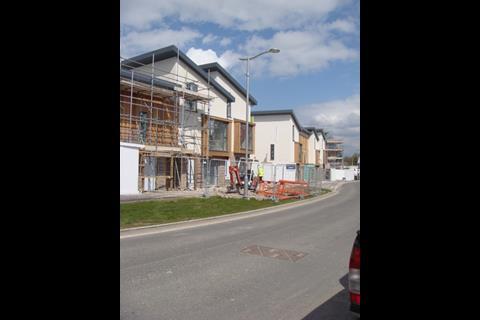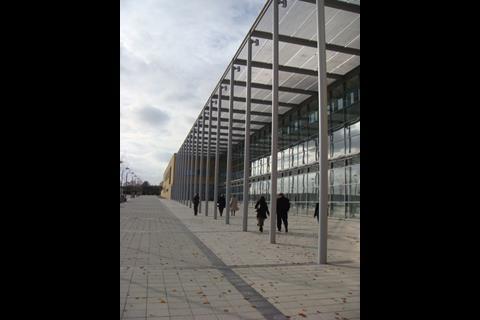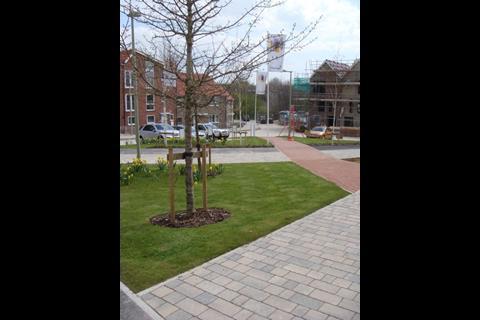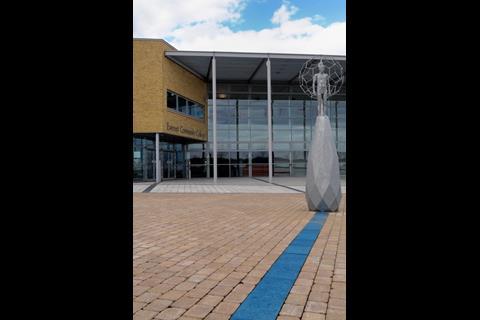Community integration and a wish to avoid a potential ŌĆÖthem and usŌĆÖ situation were key drivers in creating a new urban extension at Merton Rise in Popley.
Carried out well, urban extensions can bring much needed investment into the wider area, providing existing and new communities alike with new infrastructure and facilities.
But paramount to their success is making sense of the needs of current and future communities and ŌĆō critically ŌĆō ensuring that community integration and connectivity lies at the heart of regeneration plans.
On the fringes of Basingstoke, the 3,500 strong town of Popley was developed in the 1970s as an overspill for LondonŌĆÖs social housing boom.
Never an affluent area, and with considerable regeneration issues, including a poorly performing secondary school, local authority and landowner Hampshire County Council first came up with regeneration plans for the town in the 1990s.
To create a vision for the site, the council assembled a masterplanning team including Tibbalds Planning and Urban Design, HED Landscape Architects, transport consultancy MVA, engineers Campbell Reith and members of the councilŌĆÖs in-house development and engineering teams.
The result was a masterplan for a new urban extension on a 50-hectare site near Popley called Merton Rise that would deliver benefits to the entire area, including 950 homes, a new local town centre and a replacement secondary school.
From the outset, it was clear the project faced some significant challenges. A key priority was to make sure Merton Rise engaged with Popley, improving life not just for new but also for existing residents, so that the two communities worked together, not separately.
A number of innovative solutions were identified to ensure both a visual and physical relationship was created between Merton Rise and Popley.
New secondary school
One of the most important of these was the location of the new secondary school. Placing it in the urban extension would encourage existing communities to interact with Merton Rise, and routes, streets and spaces were strategically planned to maximise the schoolŌĆÖs relationship with new and existing areas.Important changes were also planned for Popley Way, the main distributor road between the two communities, which was blighted by high traffic speeds, few pavements and a series of unattractive underpasses. These included creating a number of new ground level crossings, removing several underpasses and creating new routes through Merton Rise to the new school and beyond.
Shaping the masterplan: ensuring quality and consistency
Hampshire County Council has taken on the role of master developer for its larger sites. At Merton Rise it was responsible for strategic infrastructure and most of the public realm, and for marketing residential and mixed-use development through a co-ordinated site disposal process that was developed in conjunction with the masterplanning team.
Tibbalds and the project team worked together over several years to develop the Merton Rise masterplan. The masterplan is based around the linear nature of the site, organising the development as a string of open spaces, parks and squares along a spine road that winds along the south-facing site. Cutting across this road are a series of lateral routes connecting the development and its facilities with the surrounding neighbourhoods.
As well as a series of distinctive neighbourhoods, the Merton Rise plans also set out a new neighbourhood centre, with a supermarket, shops, offices, nursery and family pub within walking distance for new and existing residents.
A key design challenge of the neighbourhood centre was to create something that felt like a ŌĆśreal placeŌĆÖ featuring qualities belonging to town and village high streets and centres across Hampshire. Tibbalds approach was to create a square at the intersection of the spine road and the principal north-south route that connects the new school and school square down to Popley Way and the existing community. The neighbourhood centre is arranged around the square, in mixed use buildings that overlook this space ŌĆō creating a safe space for relaxing, playing and enjoying.
A key strength of the masterplanning process was the positive and collaborative working relationships that developed among members of the project team. Other factors that have helped achieve a successful outcome include having a shared vision, developing a clear understanding of the site and its context, setting a clear ŌĆśbest practiceŌĆÖ agenda and branding the project, actively marketing the sites to high profile architects and developers.
A design-led strategy
Because the disposal strategy for the site involved a large number of different development partners and parcels of land, it was clear from the start that Merton Rise needed a strong design concept and character.Hilary Satchwell, a Director at Tibbalds Planning and Urban Design says: ŌĆ£We wanted to avoid each developer making each parcel of land completely different from the next. Instead, we wanted Merton Rise to have an overall sense of coherence across the whole site, and to use the topography to create an unfolding townscape as you pass through.ŌĆØ
So the masterplanning team developed a strong, contemporary design vision for the site, which was then used as the basis for a series of specific briefs that establish some fixed elements for designers to respond to, while at the same time leaving plenty of room for innovation and creativity.
As well as establishing a strong, coherent design concept for the scheme, the team also wanted to promote high quality design right across the development.
Hampshire County Council took a range of steps to ensure this, including introducing a two stage tender process with only the best designs being invited to progress to the second stage.
Also central to the creation of the right ŌĆślook and feelŌĆÖ was the development of a materials strategy, to ensure Merton Rise would relate to the local area. This includes, for example, the use of soft red brick, a highly distinctive feature of North Hampshire, often highlighted with render or timber cladding.
The masterplan alive: Merton Rise today
Today at Merton Rise, implementation of the masterplan is well underway. The masterplanning teamŌĆÖs work has been rewarded by the positive results of the first two phases, with the development attracting both major house builders and award winning architects.The new state-of-the-art Everest Community College opened in September 2007, funded by the land it replaces and by developersŌĆÖ contributions. Its role as a catalyst for community integration is already clear.
ŌĆ£The schoolŌĆÖs community area provides a fantastic opportunity to bind relationships between the areas,ŌĆØ says Camilla Bolton, who has moved from the old school to Everest College. ŌĆ£I feel like they have carefully thought out the position of the school and thereŌĆÖs been a really positive reaction to the development.ŌĆØ
Other elements of the development now complete include a striking, new, modern housing development by Frazer Brown McKenna for Miller Homes, and housing around a new square in line with the concepts produced by HTA Architects and Wayne Hemingway for Wimpey. A new local park incorporating a space age play area and public art will be a community favourite.
And according to Hilary Satchwell, the design-led strategy is paying off too.
ŌĆ£The positive collaborative relationships established between the masterplanning team and designers working on the school and the first parcels of land have worked well in ensuring that a strong overall vision is realised. This work has also shown that some house builders are open to thinking outside their comfort zone and can deliver interesting, townscape-led housing.ŌĆØ
The signs are good, but itŌĆÖs early days.
ŌĆ£From conversations IŌĆÖve had I would say that there is an air of positive anticipation about the developments and the potential they hold for raising the profile of Popley as a great place to live,ŌĆØ says local reverend Arthur Popley.
However, he also cautions that a programme of active engagement and promotion will be important to ensure that a genuine and lasting relationship is built between the old and new communities.
The success of the Merton Rise masterplan has informed work on other sites being developed by Hampshire County Council. As well as providing a model of best practice for procurement and planning processes, the project has shown how to achieve a high level of certainty and, through collaborative working, secure buy-in from all those involved in the planning and development process.
Hampshire Country Council is now a strong advocate of a design-led masterplanning approach too, according to Louise Hague of the councilŌĆÖs Development and Projects Group. ŌĆ£The involvement of Tibbalds has enabled council officers to gain an increased appreciation of the value of urban design in development,ŌĆØ she says.
In short, Merton Rise demonstrates how local authorities, communities and developers alike can benefit from keeping an eye on the bigger regeneration picture.

































